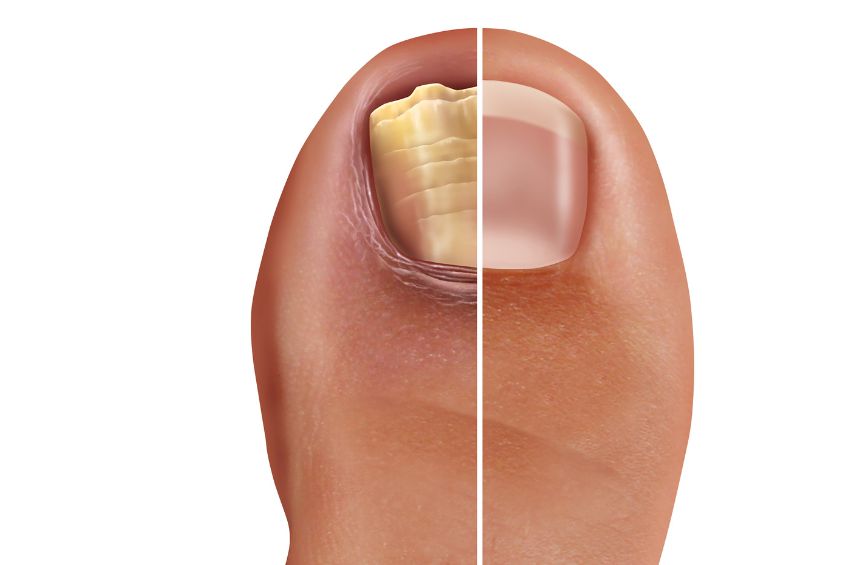Winter may be approaching but that doesn’t mean you can’t still pamper yourself. You might want to get a pedicure so your feet look their best, but if you are worried about a potential fungal infection and how this will affect the results of your pedicure then you are not alone.
A pedicure will not harm or help nails with a fungal infection, but you should not get a pedicure with toenail fungus because you might inadvertently spread the fungus to salon employees and patrons. Instead, treat the infection or see a doctor before getting a pedicure.
Toenail fungus happens to the best of us. While it might be unsightly and even uncomfortable, there is hope – arm yourself with some knowledge about toenail fungus and how to treat it by reading on. Knowledge is power in the fight against fungal infections!
Understanding Toenail Fungus
Being human is tough. We have to worry about all kinds of pathogens, with toenail fungus being among the more common ailments afflicting humanity’s feet since time immemorial. Thankfully, in this long history, we have developed some understanding of the fungus that causes the funk.
What Does Toenail Fungus Look Like?

Toenail fungus is easily identifiable (1). Infected nails will be discolored, often yellowing, sometimes even green or black. Instead of looking smooth and healthy, infected nails will have a ragged, misshapen appearance. In some cases, the nail will begin separating from the nail bed, and often will be accompanied by a smell.
Infections usually start at the tip of the nail bed, eventually spreading across the nail causing a streaky appearance. It can be extremely uncomfortable, causing pain and inflammation in the skin surrounding the nail.
What Causes Toenail Fungus?
Toenail fungus can be caused by a variety of molds, yeasts, and bacteria. These organisms grow in and around nails, especially favoring the warm, moist environment of closed shoes.
Toenail fungus is associated with poor circulation in the feet, and those with diabetes or who are of advanced age are particularly susceptible to it. It can affect anyone, though. Infections are often spread in places where moisture and bare feet meet, such as locker rooms and public pools.
To avoid toenail fungus, take care to keep your feet clean and dry. Wash your feet regularly, and if you already have an infection always wash your hands if you touch it to avoid spreading the infection.
Those with diabetes should be especially wary of infection and should consult a medical practitioner at the earliest convenience if infected. Older and immunocompromised individuals should take similar care, as these infections have a tendency to spread beyond the feet and cause other complications.
Be Honest With Your Pedicurist
Don’t try to hide a fungal infection – a nail technician will want to know about it in advance. Some pedicurists might agree to proceed depending on the severity of your fungus, and will at least be able to plan ahead for sterilizing their equipment and preventing their other customers from being exposed.
Consider moving your appointment to a later date so you can treat your infection first. Imagine how you would feel finding out one day that another client got severely infected and caused a salon to shut its doors. Infections happen, and your pedicurist will certainly be grateful to know about them.
Ultimately it would be irresponsible and dishonest to knowingly attend an appointment with a fungal infection without informing the salon. It’s not only a risk to their business, but a potentially severe health risk for diabetics, elders, and those with weak immune systems. Don’t do it.
How to Treat Toenail Fungus
Over the years, many treatments to toenail fungus have been created and attempted. Thankfully most people respond well to natural fungus treatments, avoiding the side effects associated with pharmaceutical treatments.
Fungix™ by Approved Science® is one of the leading natural remedies to help fight and prevent nail fungus. The treatment includes a nail protein to help strengthen and support healthy nails, as well as an advanced blend of natural oils that is proven and backed by science to destroy the organisms that attack our nails.

Prevention is always better than a cure when it comes to toenail fungus, so inform yourself with some tips on how to keep your hands (and feet) looking young and healthy. That said, it’s always best to consult a professional if you have any doubts. Toenail fungus can permanently damage your nails, so err on the side of caution.
Your Takeaway
Toenail fungus sucks, but it’s not the end of the world. Caught early, it can be treated successfully but those infected should steer clear of pedicures and treat their fungus first. There are natural options like Fungix™ that offer first-class treatment for most cases of toenail fungus, but one should always consult a professional when in doubt especially with conditions like diabetes and advanced age.

